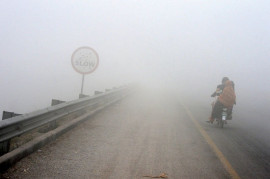
“Heavy government borrowing from banks resulted in a liquidity crisis, which badly hit local industries,” CEO Topline Securities Muhammad Sohail said. He described shortage of liquidity as the biggest problem for the industries this year.
Professor Dr Shahida Wizarat, Head of Research at the Department of Economics at the Institute of Business Management (IoBM), said the industries were facing scores of problems which directly affected their growth.
She said that 2010 had been another tough year for the industries during which law and order, energy shortage, sharp increase in utility tariffs and cost of production blocked the growth of economy.
“Basically, our economic policies are not conducive for the growth of industry. The policies, dictated by the International Monetary Fund and adopted by our successive governments over the last 20 years, have proved anti-industry time and again,” she stressed.
The cost of production has been increasing owing to costly energy in which the reliance on imported oil plays a big role, Wizarat said, adding that high interest rates have also discouraged the industry from borrowing from banks.
However, State Bank of Pakistan (SBP) Governor Shahid Kardar recently defended the tight monetary policy of the central bank, saying it was necessary to control inflation which hovers over 15 per cent.
Kardar said: “I can stop lending money to the government immediately but as a result, the government will borrow from commercial banks on interest rates higher than the SBP, and the industry will have to borrow on even higher rates from commercial banks.”
Adviser to the Sindh Chief Minister on Investment, Zubair Motiwala, had similar views echoed by other experts. He stressed that power and gas shortages topped the list of hurdles faced by the industries during the year.
Though competing countries had increased their subsidies to their respective industries, Pakistan had been struggling to cope with the energy crisis, which reached its peak during the current year. Most importantly, cotton prices shot up 150 per cent in the second half of 2010, he said.
Motiwala, who is associated with the textile sector, said the continuous rise in the cost of manufacturing is now unbearable for the industry.
However, he said that despite serious problems facing the economy, Pakistan can still double its exports over the next two years. “We just need conducive policies for two to three years. We need to change our mindset and fully support our export-based industries.”
For the upcoming year 2011, Motiwala predicted that major problems like law and order and energy shortage are likely to persist. He anticipated that exports will increase this financial year ended June 30, 2011 because of high cotton and rice prices in the international market and may cross $21 billion.
Former chairman SITE Association of Industry, Nisar Shekhani, said that 2010 was a very difficult year for the industry on various fronts. Provinces in the northern part of the country faced acute energy shortages throughout the year while in the southern part law and order and electricity were major hindrances.
A controversy that gripped the country this year was the reformed general sales tax (RGST). The government first announced that it will impose RGST from October 1 and then on January 1, 2011 but it is still not clear when the tax structure will be introduced. Since textile is one of the five zero-rated sectors, it would be difficult for this industry to go along with the RGST, Shekhani added.
Referring to the energy crisis, he commented that “though circular debt and energy crisis were problems that cropped up during the tenure of the previous government, the present government has to solve these which are now badly hurting the industrial sector.”
Published in The Express Tribune, December 28th, 2010.





1734951821-0/Copy-of-Untitled-(88)1734951821-0-270x192.webp)

1734899716-0/image-(15)1734899716-0-270x192.webp)








1734778885-0/Untitled-(10)1734778885-0-270x192.webp)






COMMENTS
Comments are moderated and generally will be posted if they are on-topic and not abusive.
For more information, please see our Comments FAQ